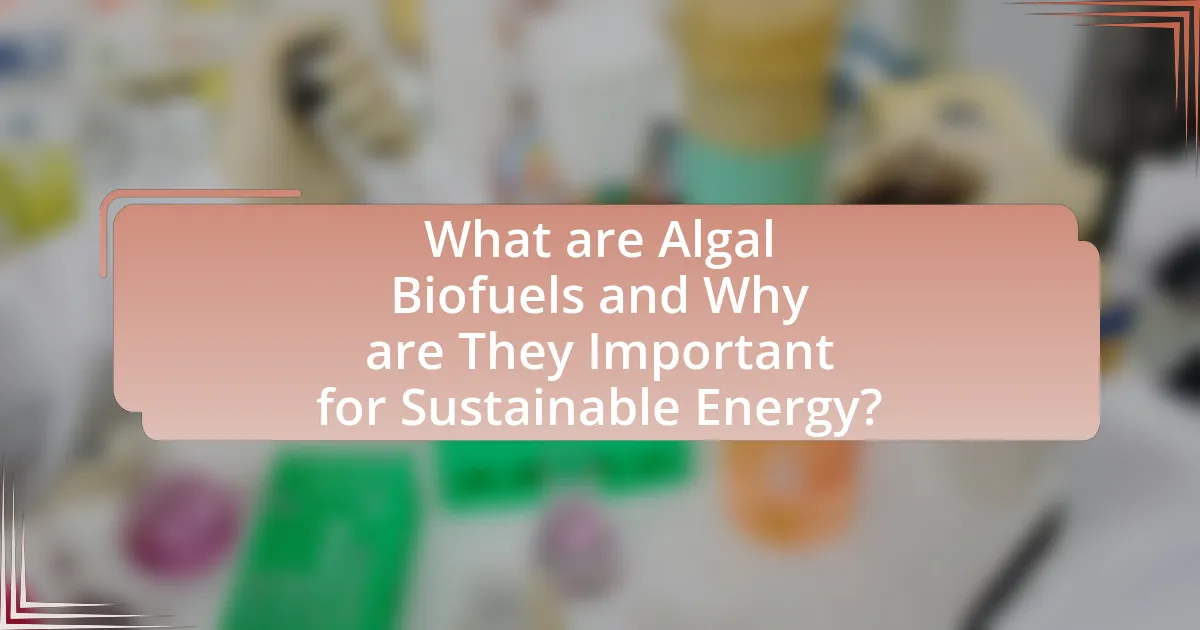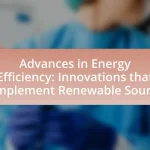Algal biofuels, derived from algae, represent a promising renewable energy source that can be converted into biodiesel, bioethanol, and other fuels. They offer significant advantages over traditional biofuels, including higher energy yields per acre, reduced freshwater requirements, and the ability to grow on non-arable land, thereby minimizing competition with food crops. The article explores the production processes, environmental benefits, and challenges associated with algal biofuels, including high production costs and technological limitations. Additionally, it discusses the potential applications of algal biofuels across various industries and the importance of strategic partnerships and government policies in advancing their commercialization and integration into the energy market.

What are Algal Biofuels and Why are They Important for Sustainable Energy?
Algal biofuels are renewable energy sources derived from algae, which can be converted into biodiesel, bioethanol, and other forms of fuel. They are important for sustainable energy because they offer a high yield of energy per acre compared to traditional crops, require less freshwater, and can utilize non-arable land, thus minimizing competition with food production. Additionally, algal biofuels can significantly reduce greenhouse gas emissions; for instance, studies indicate that they can lower carbon dioxide emissions by up to 70% compared to fossil fuels. This makes algal biofuels a promising alternative in the transition towards a more sustainable energy future.
How do algal biofuels differ from traditional biofuels?
Algal biofuels differ from traditional biofuels primarily in their source and production efficiency. Algal biofuels are derived from algae, which can produce significantly higher yields of oil per acre compared to traditional biofuels sourced from crops like corn or soybeans. For instance, algae can produce up to 5,000 gallons of oil per acre annually, while traditional crops typically yield around 50 to 100 gallons per acre. Additionally, algae can grow in a variety of environments, including saltwater and wastewater, reducing competition for arable land and freshwater resources. This makes algal biofuels a more sustainable option, as they can utilize non-potable water and do not require the same agricultural inputs as traditional biofuels.
What types of algae are used for biofuel production?
The types of algae used for biofuel production include microalgae and macroalgae. Microalgae, such as Chlorella, Spirulina, and Scenedesmus, are particularly valued for their high lipid content, which can be converted into biodiesel. Macroalgae, like kelp and seaweed, are also explored for bioethanol and biogas production due to their carbohydrate-rich composition. Research indicates that microalgae can produce up to 30 times more oil per acre than traditional crops, making them a promising source for sustainable energy solutions.
What are the key processes involved in converting algae to biofuels?
The key processes involved in converting algae to biofuels include cultivation, harvesting, lipid extraction, and transesterification. Cultivation involves growing algae in controlled environments, utilizing sunlight and nutrients to maximize biomass production. Harvesting follows, where the algae are collected, often using methods like centrifugation or filtration. Lipid extraction is the next step, where oils are separated from the algal biomass, typically using solvents or mechanical processes. Finally, transesterification converts the extracted lipids into biodiesel through a chemical reaction with alcohol, producing fatty acid methyl esters. These processes are essential for transforming algal biomass into viable biofuels, contributing to sustainable energy solutions.
What environmental benefits do algal biofuels provide?
Algal biofuels provide significant environmental benefits, including reduced greenhouse gas emissions and improved carbon capture. These biofuels can lower carbon dioxide emissions by up to 70% compared to fossil fuels, as algae absorb CO2 during their growth process. Additionally, algal biofuels can be produced using non-arable land and wastewater, minimizing competition with food crops and reducing nutrient pollution in water bodies. Studies indicate that algae can yield up to 30 times more oil per acre than traditional crops, making them a highly efficient renewable energy source.
How do algal biofuels contribute to reducing greenhouse gas emissions?
Algal biofuels contribute to reducing greenhouse gas emissions by utilizing carbon dioxide during their growth process, effectively sequestering this greenhouse gas. Algae can absorb CO2 from the atmosphere or from industrial emissions, converting it into biomass through photosynthesis. Studies indicate that algal biofuels can reduce lifecycle greenhouse gas emissions by up to 70% compared to fossil fuels, as they release significantly less CO2 when burned. Additionally, the cultivation of algae can be done on non-arable land and with minimal freshwater, further minimizing environmental impact and promoting sustainability.
What role do algal biofuels play in biodiversity conservation?
Algal biofuels contribute to biodiversity conservation by providing a sustainable energy source that reduces reliance on fossil fuels, which are a major driver of habitat destruction and climate change. The cultivation of algae for biofuels can be done on non-arable land and using wastewater, minimizing competition with food crops and preserving natural ecosystems. Additionally, algal biofuels can help mitigate greenhouse gas emissions, thereby reducing climate change impacts that threaten biodiversity. Studies indicate that transitioning to algal biofuels could significantly lower carbon emissions, which is crucial for protecting diverse species and their habitats.

What are the Challenges Facing Algal Biofuel Production?
The challenges facing algal biofuel production include high production costs, technological limitations, and scalability issues. High production costs arise from the need for specialized cultivation systems, nutrient inputs, and harvesting processes, which can exceed the costs of traditional fossil fuels. Technological limitations involve the efficiency of converting algal biomass into usable fuel, as current methods often yield low energy outputs. Scalability issues stem from the difficulty in producing algal biofuels at a scale sufficient to meet energy demands, as large-scale cultivation can be hindered by environmental factors and resource availability. These challenges collectively impede the widespread adoption of algal biofuels as a viable alternative energy source.
What are the economic barriers to algal biofuel commercialization?
The economic barriers to algal biofuel commercialization include high production costs, limited scalability, and competition with established fossil fuels. High production costs arise from the need for advanced cultivation systems, harvesting technologies, and processing methods, which can exceed $10 per gallon, making algal biofuels less competitive compared to traditional fuels priced around $3 per gallon. Limited scalability is a challenge because current production methods are not yet capable of meeting large-scale demand, and the technology for efficient large-scale cultivation is still under development. Additionally, established fossil fuel markets benefit from existing infrastructure and subsidies, making it difficult for algal biofuels to gain market share. These factors collectively hinder the economic viability of algal biofuels in the current energy landscape.
How do production costs compare to fossil fuels?
Production costs for algal biofuels are generally higher than those for fossil fuels. While fossil fuel production costs can range from $30 to $70 per barrel, algal biofuels currently average around $100 to $200 per barrel. This disparity is primarily due to the complexities involved in cultivating, harvesting, and processing algae, which require advanced technology and infrastructure. Additionally, fossil fuels benefit from established supply chains and economies of scale, further reducing their costs.
What technological advancements are needed to improve efficiency?
To improve efficiency in algal biofuels, advancements in genetic engineering, photobioreactor design, and harvesting technologies are essential. Genetic engineering can enhance algal strains to increase lipid production, with studies showing that genetically modified strains can yield up to 50% more oil compared to wild types. Improved photobioreactor designs, such as those utilizing light-emitting diodes (LEDs) for optimized light exposure, can significantly boost photosynthetic efficiency, leading to higher biomass yields. Additionally, advancements in harvesting technologies, like membrane filtration and centrifugation, can reduce energy costs and increase the recovery rate of algal oils, with some methods achieving over 90% recovery efficiency. These technological improvements collectively contribute to making algal biofuels a more viable and sustainable energy source.
What regulatory and policy challenges exist for algal biofuels?
Regulatory and policy challenges for algal biofuels include a lack of clear regulatory frameworks, insufficient funding for research and development, and competition with established energy sources. The absence of specific guidelines for algal biofuel production and commercialization creates uncertainty for investors and developers, hindering progress in the sector. Additionally, funding from government programs is often limited, which restricts innovation and scaling of algal biofuel technologies. Furthermore, algal biofuels face competition from fossil fuels and other renewable energy sources that benefit from more established policies and subsidies, making it difficult for algal biofuels to gain market traction.
How do government incentives impact algal biofuel development?
Government incentives significantly accelerate algal biofuel development by providing financial support and reducing investment risks. These incentives, such as tax credits, grants, and subsidies, lower the cost of research and production, making algal biofuels more competitive with traditional fossil fuels. For instance, the U.S. Department of Energy has allocated millions in funding for algal biofuel projects, which has led to advancements in technology and increased commercial interest. Additionally, countries like Brazil and the European Union have implemented policies that promote renewable energy sources, further driving innovation and investment in algal biofuels.
What international policies affect algal biofuel markets?
International policies that affect algal biofuel markets include the Renewable Energy Directive (RED) of the European Union, which sets targets for renewable energy use and promotes biofuels, including algal biofuels, as part of its sustainability goals. Additionally, the United Nations Framework Convention on Climate Change (UNFCCC) influences algal biofuel markets by encouraging countries to adopt renewable energy sources to meet climate commitments. The International Energy Agency (IEA) also plays a role by providing guidelines and support for biofuel development, including algal biofuels, through its Bioenergy Technology Collaboration Programme. These policies collectively create a regulatory environment that can either promote or hinder the growth of algal biofuel markets globally.

How Can Algal Biofuels Be Integrated into the Energy Market?
Algal biofuels can be integrated into the energy market through strategic partnerships with existing energy companies, investment in infrastructure for production and distribution, and government policies that support renewable energy sources. By collaborating with established energy firms, algal biofuel producers can leverage existing supply chains and distribution networks, facilitating market entry. Investment in facilities that convert algal biomass into biofuels is essential; for instance, the construction of biorefineries can enhance production efficiency and reduce costs. Furthermore, supportive government policies, such as tax incentives and renewable energy mandates, can create a favorable environment for algal biofuels, encouraging adoption and investment. According to the U.S. Department of Energy, algal biofuels have the potential to provide up to 17% of the nation’s transportation fuel by 2030, highlighting their viability in the energy market.
What are the potential applications of algal biofuels in various industries?
Algal biofuels have potential applications across multiple industries, including transportation, energy production, and agriculture. In the transportation sector, algal biofuels can serve as a renewable alternative to fossil fuels, reducing greenhouse gas emissions; for instance, biodiesel derived from algae can power vehicles with lower carbon footprints. In energy production, algal biofuels can be converted into electricity or heat, contributing to a more sustainable energy grid. Additionally, in agriculture, algal biofuels can be utilized as a source of nutrients for crops, enhancing soil health and promoting sustainable farming practices. These applications are supported by research indicating that algal biofuels can produce up to 30 times more oil per acre than traditional crops, making them a viable option for meeting global energy demands while minimizing environmental impact.
How can algal biofuels be used in transportation?
Algal biofuels can be used in transportation as a renewable energy source that can replace conventional fossil fuels. These biofuels, derived from algae, can be processed into biodiesel, ethanol, or jet fuel, providing a sustainable alternative for vehicles, ships, and aircraft. Research indicates that algal biofuels can produce up to 30 times more oil per acre than traditional crops, making them a highly efficient option for reducing greenhouse gas emissions and dependence on fossil fuels. Additionally, the U.S. Department of Energy has identified algal biofuels as a key component in achieving energy security and sustainability in the transportation sector.
What role do algal biofuels play in electricity generation?
Algal biofuels serve as a renewable energy source for electricity generation by converting biomass from algae into energy-rich fuels. These biofuels can be used in various energy conversion technologies, such as combustion, gasification, and anaerobic digestion, to produce electricity. Research indicates that algal biofuels have a higher energy yield per acre compared to traditional crops, with some studies showing potential yields of up to 10,000 gallons of oil per acre annually. This efficiency, combined with the ability of algae to absorb carbon dioxide during growth, positions algal biofuels as a sustainable alternative to fossil fuels in electricity generation.
What strategies can enhance the adoption of algal biofuels?
To enhance the adoption of algal biofuels, strategies must focus on reducing production costs, improving technology, and increasing public awareness. Reducing production costs can be achieved through advancements in cultivation techniques and genetic engineering of algae to increase yield and efficiency. For instance, research indicates that optimizing nutrient delivery and using waste streams can significantly lower costs. Improving technology involves developing more efficient harvesting and processing methods, which can streamline production and make algal biofuels more competitive with fossil fuels. Additionally, increasing public awareness through education campaigns can foster acceptance and demand for algal biofuels, as studies show that informed consumers are more likely to support sustainable energy sources.
How can public awareness and education improve algal biofuel acceptance?
Public awareness and education can significantly improve algal biofuel acceptance by informing the public about its benefits and addressing misconceptions. Increased knowledge about algal biofuels, such as their potential to reduce greenhouse gas emissions and their sustainability compared to fossil fuels, can lead to greater public support. For instance, studies have shown that when individuals are educated about the environmental advantages of algal biofuels, such as their ability to utilize carbon dioxide and produce oxygen, acceptance rates increase. Furthermore, educational initiatives can dispel myths regarding production costs and technological feasibility, fostering a more informed public that is likely to advocate for policies supporting algal biofuel development.
What partnerships are essential for advancing algal biofuel initiatives?
Essential partnerships for advancing algal biofuel initiatives include collaborations between research institutions, private companies, and government agencies. Research institutions provide the scientific expertise necessary for developing efficient algal strains and cultivation techniques. Private companies contribute funding, technology, and market access, which are crucial for scaling production. Government agencies play a vital role by offering regulatory support, funding opportunities, and incentives for renewable energy projects. For instance, the U.S. Department of Energy has invested in algal biofuel research, highlighting the importance of public-private partnerships in driving innovation and commercialization in this sector.
What are the best practices for developing algal biofuel projects?
The best practices for developing algal biofuel projects include selecting suitable algal strains, optimizing growth conditions, and implementing efficient harvesting techniques. Selecting strains with high lipid content, such as Nannochloropsis or Chlorella, ensures better biofuel yield. Optimizing growth conditions involves controlling light, temperature, and nutrient availability to maximize biomass production; for instance, studies show that specific nutrient ratios can enhance lipid accumulation. Efficient harvesting techniques, such as centrifugation or flocculation, reduce costs and improve the overall process efficiency. These practices are supported by research indicating that optimizing these factors can significantly increase the viability and sustainability of algal biofuel production.
How can stakeholders effectively collaborate in algal biofuel research?
Stakeholders can effectively collaborate in algal biofuel research by establishing multi-disciplinary partnerships that integrate expertise from academia, industry, and government. These collaborations can enhance resource sharing, facilitate knowledge transfer, and promote innovation. For instance, joint research initiatives, such as the Algal Biomass Organization, have successfully united various stakeholders to advance algal biofuel technologies, demonstrating that collaborative efforts can lead to significant advancements in production efficiency and cost reduction. Additionally, funding mechanisms like the U.S. Department of Energy’s Bioenergy Technologies Office support collaborative projects, providing financial resources that incentivize partnerships and accelerate research outcomes.
What are the key considerations for sustainable algal biofuel production?
Key considerations for sustainable algal biofuel production include resource efficiency, environmental impact, and economic viability. Resource efficiency focuses on optimizing the use of water, nutrients, and light to maximize algal growth and oil yield. Environmental impact involves assessing the lifecycle emissions and potential ecological effects of algal cultivation, ensuring that production does not harm local ecosystems. Economic viability requires analyzing production costs, market demand, and scalability to ensure that algal biofuels can compete with fossil fuels and other renewable energy sources. These considerations are crucial for developing a sustainable algal biofuel industry that contributes to energy needs without compromising environmental integrity.


